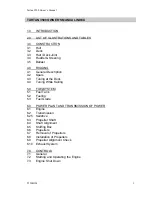
Printed 7/2/2016
MV Lioness Owners Notes v2015.2
Page 12 of 36
14.
To clear the strainer, close the seacock (open lock nut opposite
handle), remove the basket and any debris. Replace the basket and
re-open the seacock. The starboard basket does not come all the
way out. Remove what you can see.
15.
Leave the keys to the respective engines in the ignition slots on the
helm.
16.
To start one engine, turn the respective key to the “ON” position (the
alarm will sound signifying low oil pressure). Then push the start
button for the same engine for a few seconds, the engine should
start easily. When the engine starts, adjust the idle to 800 RPM for
that engine. Repeat the above procedure for the second engine.
Diesel engines should only ‘warm up’ for 3-4 minutes. No need to
get to ‘operating temperature’ to engage gears. Go to stern and look
to make sure water is flowing from exhausts on both sides.
17.
Push the power button at the bottom of the thruster control. The
thruster power is “ON” when the green light is illuminated on the
control. Turning on the lower helm thruster control does not turn on
the upper helm or aft helm control. Each thruster must be activated
individually.
18.
After the engines run for a minute or two idle the engines down.
You may test the bow thruster both left and right by moving the
lever for a half second in each direction.
19.
You are ready to untie from your moorage and maneuver away.
20.
It is good to station your crew around Lioness as additional eyes to
make sure you have lots of clearance from obstructions. It is often
helpful to have one crew member with the extra fender in hand
available to place the fender between the boat and any hard object if
you come too close. NEVER try to fend off with your hands or feet!
21.
Remember, Lioness is 54’ overall in length and has a beam of 15'.
Bridge clearance is approximately 25’ above the water. She weighs
27.5 tons and will react slowly but predictably.
22.
Make sure all mooring lines, fenders and anything that is loose is
stowed before getting underway. No lines should be stored in the
port or starboard walkways as they could fall overboard and foul the
props.
23.
Turn on the stabilizers only when you are under way and will not be
using reverse to maneuver. If the stabilizers are on when reversing,
they will try to balance the boat while moving backwards and may
give unpredictable results.
24.
Turn on the VHF radios, (monitor channel 16) and the auto pilot if
you are using it.
25.
For navigation gear, make sure all switches on the ‘nav panel’ are
switched on. Turn on each unit individually. Garmin 7607 (on top of
nav area) is designed to be moved to flybridge when needed. Press













































